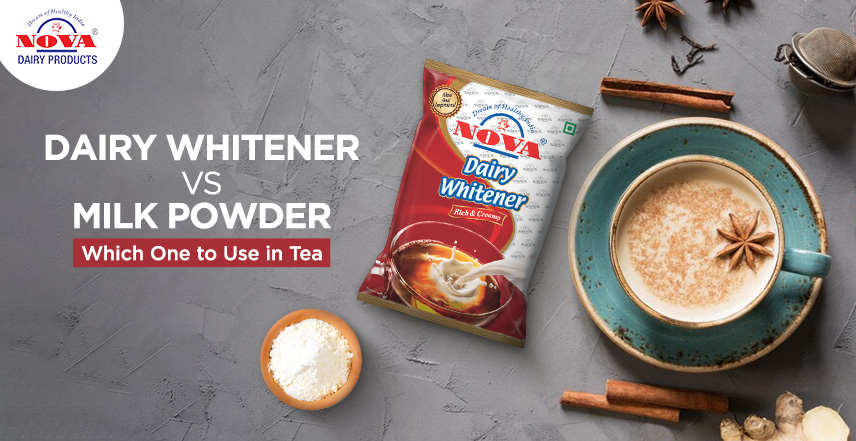For many people, tea is part of daily life. While some prefer to use fresh milk, others look for alternatives that are easier to store and use. Two common choices are dairy whitener and milk powder. Both are made from milk solids. Both are available in powdered form. But they are not the same, especially when used in tea.
If you’ve noticed a difference in taste, texture, or how they mix, you’re not wrong. The reason lies in how these two products are made and what they’re meant for.
This article explains the differences between dairy whitener and milk powder, focusing on how each one works in tea. If you are trying to decide which one to use, this guide will help you make an informed choice.
What is Dairy Whitener?
Dairy whitener is made by processing milk solids to create a powder that dissolves easily in hot liquids. Unlike plain milk powder, it also contains a small amount of sugar and stabilisers. These additions are not for flavour enhancement alone; they serve a functional purpose.
The stabilisers help the dairy whitener mix smoothly into tea and coffee, without curdling or forming lumps. The slight sweetness balances the bitterness of tea, giving a rounder flavour. Its formulation is designed specifically for beverages, offering the convenience of long shelf life and instant use.
For people who make tea multiple times a day or need a quick solution in offices or while travelling, dairy whitener is a practical alternative to fresh milk.
What Milk Powder Is Meant For
Milk powder is simply dehydrated milk. It retains most of the nutritional components of milk and is used widely in cooking, baking, and sweet-making. Unlike dairy whitener, it is generally free from added sugar and stabilisers.
When used in tea, milk powder can replicate the presence of milk solids, but it requires more careful handling. It does not dissolve as quickly or as smoothly. Often, it needs to be mixed with warm water separately before being added to tea to avoid lumps. Without this step, it tends to float unevenly or settle at the bottom.
While milk powder works well in recipes that need concentrated milk, it is not actually created for beverages like tea or coffee.
How Dairy Whitener Performs in Tea
For tea preparation, the biggest advantage of dairy whitener is its ease of use. It dissolves almost instantly, giving tea a creamy consistency similar to fresh milk. You do not need to whisk it vigorously or follow special steps to mix it in.
Another factor is stability. When added to hot tea, dairy whitener maintains a homogenous texture. It does not curdle easily, even if the tea is very hot. This makes it reliable for daily use.
Taste-wise, dairy whitener provides a balanced, mildly sweet flavour. Many people find that it closely matches the richness of full-cream milk in tea, making it a suitable alternative when fresh milk is not available.
How Milk Powder Behaves in Tea
Using milk powder in tea is possible but less convenient. Since it lacks the quick-dissolving properties of dairy whitener, it requires more effort to blend smoothly. If added directly to hot tea, it may form lumps or create a grainy texture.
To get a smoother result, milk powder should first be dissolved in a small amount of warm water, then added to the brewed tea. Even with this method, the texture might not be as creamy as tea made with dairy whitener.
Milk powder also lacks the natural sweetness of dairy whitener. While this gives you control over how much sugar to add, it adds an extra step to the preparation process.
Which One Should You Choose for Tea?
If your priority is convenience and consistency, dairy whitener is the more suitable choice for tea. It is made for this specific purpose. You can make a cup of tea quickly, without worrying about lumps, texture issues, or additional steps.
Milk powder remains useful in recipes and dishes that require a concentrated form of milk. For tea, however, it demands more attention and does not always deliver the same smooth experience.
For someone making tea once or twice a day, this difference in performance becomes noticeable. Dairy whitener saves time while maintaining the taste and feel of a good cup of chai. However, a couple of common concerns remain.
Is Dairy Whitener Artificial?
No, dairy whitener is made from milk solids. The added sugar and stabilisers are there to improve its mixing properties and shelf life. It is not an artificial creamer or non-dairy substitute.
Is Milk Powder Healthier?
Milk powder retains more of milk’s original nutrients in their natural form. If you are looking to match the nutritional profile of fresh milk exactly, milk powder is closer. However, for tea, the small quantity used per cup makes this difference minimal in practice.
Practical Usage in Everyday Life
For busy households, offices, or situations where fresh milk storage is a problem, dairy whitener is a reliable solution. It is easy to carry, has a long shelf life, and simplifies the tea-making process. You do not need to boil milk, manage leftovers, or worry about spoilage.
Milk powder is better kept for recipes, be it sweets like barfi, bakery items, or creamy gravies. Its role in tea preparation is more of a backup, not a primary choice.
Conclusion
Both dairy whitener and milk powder are milk-based products, but their applications are different. Dairy whitener is made for tea and coffee, offering ease of use, smooth texture, and a taste that closely resembles fresh milk. Milk powder serves as a versatile milk substitute in cooking but is less efficient for tea.
If your focus is on making a good cup of tea with minimal effort, dairy whitener is the better choice. It provides the right balance of taste, texture, and convenience—qualities that matter in a busy kitchen

